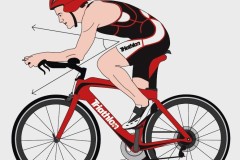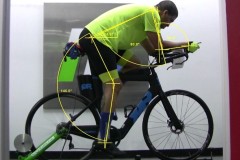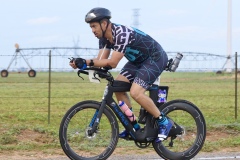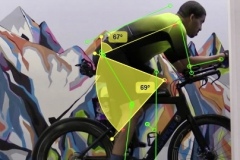When preparing to complete an event that can last six hours or more, both form and comfort are important. Maintaining proper form allows the body to work efficiently while reducing the chance of injury as fatigue accumulates. And a certain amount of comfort is needed so that we are more apt to remain in an optimal position which aids in maximizing a particular effort. An example of this is riding a triathlon bike in the “aero” position. It is an awkward position that is meant to be a compromise between comfort and efficiency. While riding a bicycle most of the drag we experience is caused by our bodies moving through the air. So, leaning into a forward position and making our bodies smaller significantly reduces drag. However, it also strains the neck and shoulders while closing the hips and can become quite uncomfortable.
Traning my body to remain in this position for hours is taking years. I began with a less-aggressive (more upright) position. Now, I feel like I can tolerate a deeper “tuck” because my shoulders are stronger and I’ve lost inches around my waist. However, adjusting the aero position is not as simple as dropping the handlebars or raising the seat, so most serious cyclists go to a professional to have this done properly.
Getting Aero
I had my first professional fitting in 2020 shortly after I began riding my tri-bike Lucy. So, in addition to being new to road cycling, I was learning to safely ride in the aero position. I didn’t have much flexibility, bike control, or confidence so my aero position was very conservative. I needed time not only to develop bike riding skills but the muscle endurance, and flexibility to sit in that position for more than 5 minutes at a time. Ultimately, my position was better than sitting straight up, but it wasn’t very aerodynamic.
Improved Aero
In January of 2022, I met with the area’s most respected bike fitter, Tad Hughes to optimize my aero position. After 90 minutes of riding, answering questions, and giving him feedback on all sorts of changes that he was making I immediately knew I’d made the right decision. I was definitely more comfortable and I could feel that my position was more aggressive than before.
The bike fit resulted in some significant adjustments:- He moved my seat backward several millimeters which allowed me to open my shoulders and increase comfort. No longer did I feel like I was fighting the feeling of falling forward.
- He raised my seat height and adjusted my cleats. This should keep my knees in proper alignment and allow for a more open hip position as I ride.
- He noted that my aero bars were too short, I need a pair that are 4-6 mm longer. My hands hang off the ends, so making them longer, and changing the shape should increase comfort and reduce forearm fatigue.








